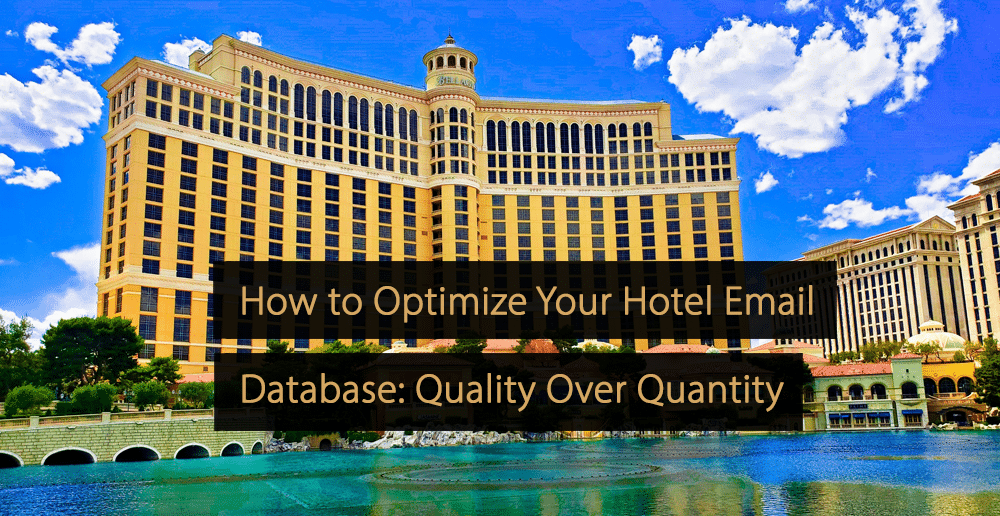
Email marketing is one of the most powerful tools hotels can use to stay connected with guests and drive bookings. But having a huge list of email addresses isn’t always a good thing. In this article, we’ll explore why quality matters more than quantity, how poor list hygiene can hurt your results, and what steps hotels can take to keep databases healthy and effective.
The Hidden Cost of a Big List
Tempted by big audiences and the lure of impressive returns, hotels often want to keep the number of email addresses in their databases high. But this is actually the downfall of many email marketing strategies.
A vast volume of contacts may seem a valuable investment; however, there’s an underlying danger that it is actually causing your hotel significant harm.
Problems with email deliverability can directly impact revenue for hotels. Spam filtering, a lack of customer engagement, and poor email data quality are all issues that contribute to this. Unopened emails, regardless of the reason, mark the beginning of a downward spiral. Open rates gradually decrease, overall engagement wanes, and revenue drops. But why?
Poor database hygiene is a root cause. Hoteliers are pretty sold on the value of email marketing. An ROI of up to $44 for every $1 spent? Yes please! But hotels won’t see anything like this 4,400% ROI if people aren’t opening the emails.
Email Lists: Quantity Doesn’t Mean Quality
Whenever you send an email, it passes through layers of service providers, including email clients, internet service providers (ISPs), and anti-spam organizations. They evaluate how your recipients interact with your emails when deciding where to place your email.
Sending to unhealthy lists or unengaged subscribers can damage your sender reputation. This increases the likelihood of your emails being flagged as spam, added to blacklists, and ultimately makes it harder to land in the inbox. You may think that’s not a big deal. Does it matter if some emails aren’t opened or land in spam folders? Open rate statistics may look a little lower, but surely, it’s better to get those emails out there to as many people as possible?
Wrong!
Sending an email to an unengaged email address gradually lowers your sender reputation, according to every email client, ISP, and anti-spam organization the email comes into contact with. This means your open rates and click-through rates will gradually but predictably get worse.
The knock-on effect? Emails bounce or land in more spam folders across the board. That means fewer bookings, reduced revenue, and a whole lot of work to get your sender reputation back on track.
How Do You Know a Guest Is Engaged?
Letting go of guest email addresses from your database is going to happen. You could have the best content, a stellar strategy, brilliant offers, and still lose some. It’s part of the circle of hotel marketing life, and it’s not something to dwell on.
So shift your mindset today. Fewer, quality email addresses will drive results – clicks, engagement, bookings, and income. Many unengaged email addresses will bring dwindling returns, and a whole lot of extra work on your plate in the future when you try to fix them.
Engaged subscribers are those who open your emails, click, and interact with your brand online. They’re much more likely to make a booking. An engaged subscriber is typically someone who has opened and clicked on an email in the last 6 months. If they haven’t opened and clicked within the last 2 years, they definitely fall into the ‘unengaged’ category. Continuing to send to them will sap your time and campaign resources, while harming your email delivery reputation.
Hotels should also look beyond just email engagement when deciding who to target. Recent guest activity is a strong indicator of interest, even if it didn’t happen in the inbox. For instance, a guest who stayed at your property within the last couple of months, or someone who booked a spa treatment or dining reservation, can be considered engaged for those segments. Including these customers in your campaigns helps you reach people who already have a fresh connection with your brand, making them more likely to respond positively to future offers.
Keeping Guests Engaged
Knowing when it’s time to say goodbye is something hotels need to learn to do in email marketing. But there are also things you can do to mitigate the need to suppress some of your hard-won guest email addresses.
- Personalize your emails. Segmenting your database helps evolve your messages from email blasts to personalized, one-to-one experiences. This is where the email engagement magic starts to happen.
- Avoid image-heavy campaigns. These trigger spam filters, cause deliverability issues, create accessibility problems, negatively affect load times – all reducing readability and open rates.
- Design with purpose. Don’t give everything away in the email itself. Campaigns should be scannable, with clear calls-to-action that entice readers to click through for more details. If you pack in every possible detail, there’s no reason for them to visit your site. Keep it simple, engaging, and always “leave them wanting to know more.”
- Analyze bounces. A hard bounce means the email address is invalid or doesn’t exist – and it should be removed from your database immediately. A soft bounce could happen for reasons outside your control, like a full inbox or recipient server issues. But it can also give you clues about your emails, including if there’s a problem with your sender reputation.
- Analyze opt-out rates and reasons. An unsubscribe rate of up to 0.3% is normal, but if it’s +1%, you need to investigate. Are you emailing too often? Is there an issue with a specific email campaign? Does the message look spammy? Is it relevant to recipients’ expectations? Ask questions until you understand the issue.
- Use the tools available. Google Postmaster is a free service enabling you to monitor and improve email deliverability in Gmail. Review resources such as Google and Yahoo sender requirements, too.
- Monitor abuse complaints. Abuse (spam) complaint rates are determined by subscribers who click ‘this is spam’ or ‘mark as junk’. A rate of up to 0.08% is normal, but if it’s +0.2%, you need to understand why.
Farewell, Isn’t Failure
The ebb and flow of email lists is real. You can’t expect to keep every guest engaged forever. It’s time to understand that saying farewell doesn’t equate to failure.
What you can do is harness the things within your control. Segment your database so you can personalize your messages. Develop brilliant, engaging email content. Support it with offers and loyalty perks that resonate. And make list hygiene a continuous process that includes sunsetting guests at the appropriate moments.
Having the confidence to suppress unengaged guests means you’ll find guests who are connected and engaged with your brand. It means you’ll be reaching guests who are more likely to book. And it will enable you to grow the things that really count – revenue, brand reputation, and an email strategy that works.
Free On-demand Webinar: Capture Online Travel Demand with Google Search
In this free webinar, you’ll explore paid search advertising for hoteliers. Learn to intercept and harness travel demand, boosting bookings and transforming online visibility into revenue.
Click here for the webinar “Capture Online Travel Demand with Google Search“.
Strong hotel email marketing starts with quality over quantity. By applying these tips and keeping your database healthy, you can improve engagement, increase bookings, and protect revenue. Take action today. Start cleaning your list today and watch your email marketing performance grow.
More Tips to Grow Your Business
Revfine.com is the leading knowledge platform for the hospitality and travel industry. Professionals use our insights, strategies, and actionable tips to get inspired, optimize revenue, innovate processes, and improve customer experience.
Explore expert advice on management, marketing, revenue management, operations, software, and technology in our dedicated Hotel, Hospitality, and Travel & Tourism categories.







